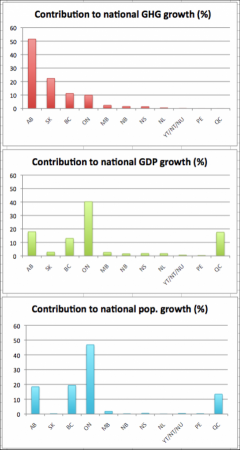The blog of the Pembina Insitute has a very interesting post on how annual greenhouse gas emissions are changing in different Canadian provinces. Since 1990, they are way up in Alberta, up a good bit in B.C. and Saskatchewan, up a little in Ontario and Manitoba, and flat in Quebec. Alberta alone contributed more than 50% of Canada’s GHG emissions growth.
These graphs – comparing contributions to GHG emissions growth, GDP growth, and population growth between 1990 and 2008 – are rather interesting:
The biggest story that jumps out at me from this is how Ontario and Quebec show that it is possible to achieve economic growth with moderate or non-existent growth in GHG emissions.Quebec added as much to Canadian GDP as Alberta did, at the same time as their emissions fell slightly.


That middle chart is a nice counter to the popular notion that Alberta is the economic engine driving Canada. Rusty old Ontario actually added the most to GDP by far.
Yes, some interesting charts, though none of them answer the question of whether it is possible to have economic growth with up to 9% p.a. sustained reductions in emissions. Also, by only looking at growth in GHG emissions, rather than absolute contributions, it is not possible to tell whether (for instance) Quebec might already have a high level of emissions per capita or per $ and other provinces are just catching up.
Further to Byron’s comment, are these moderate or non-existent GHG emission growths the result of an ongoing effort or just a side-effect of other factors?
it is not possible to tell whether (for instance) Quebec might already have a high level of emissions per capita
Canadian emissions by province
Further to Byron’s comment, are these moderate or non-existent GHG emission growths the result of an ongoing effort or just a side-effect of other factors?
Actually, this seems even more encouraging if it it accidental. If Quebec hasn’t really been motivated to make policy by climate change, yet still has flat emissions, it shows that it is at least possible to decouple emissions from GDP growth without all that much political effort.
All that said, I wouldn’t be too quick to draw excessively broad conclusions from this data. Rather, I think it provides some interesting fuel for contemplation. More analysis can be found by following the link to the Pembina site.